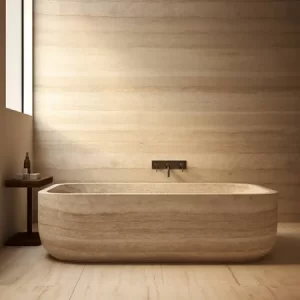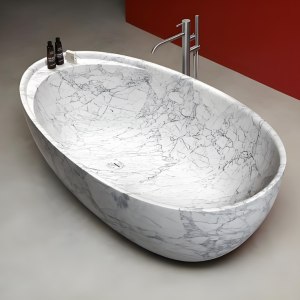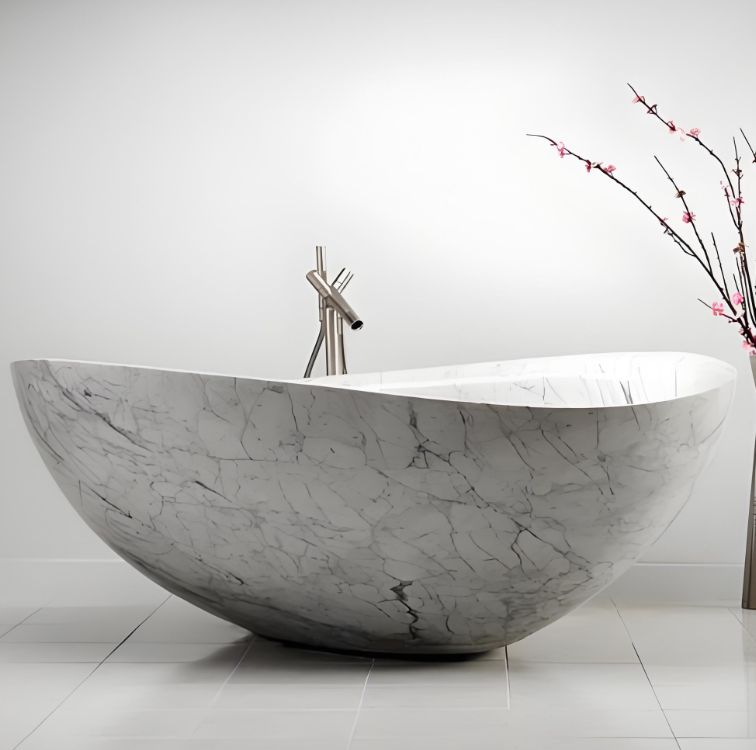Have you considered getting a more stylish bathtub for your bathroom recently? If so, the natural texture and elegance of travertine baths would have drawn your attention. This kind of bathtub is not only charming in appearance, but also can instantly enhance the temperament of the bathroom. Installing a travertine bathtub is not a casual affair, but, as a “heavy” design player! Today we will discuss how to build a travertine bathtub such that it blends exactly with your bathroom surroundings. Don’t worry, I will share the whole process with you in a relaxed and fun way, just like the two of us chatting over a cup of tea by the bathtub.

Preparing for installation
Before we start, we have to do some preparation work. It resembles cake baking. You have to have ready sugar, eggs, and flour. Otherwise, you will realise that something is absent at the crucial moment, which will cause problems. First, you have to confirm whether your bathroom structure can bear the weight of the travertine bathtub. You know, one really heavy natural stone is travertine. Apart from the weight of the bathtub itself, water and people weight are also added. Oh, that is rather weighty. The first stage is thus determining the floor’s load-bearing capacity. If you are not sure, you can ask a professional to help you.
In addition, the size of the travertine bathtub is also critical. You want not to have to move a large stone into the bathroom just to discover it cannot fit. Thus, make sure to advance measurements of the bathroom to verify whether the bathtub’s size is appropriate. There is also the location of the drain. Don’t overlook this tiny element. Water may flow through after all, hence our “bath plan” can go without any problems.
Choose a suitable base
After choosing the bathtub and determining the load-bearing capacity and space size of the bathroom, the next step is to choose a suitable base for your travertine bathtub. Why is a base necessary? Apart from stabilising the bathtub, the base shields the contact area between it and the ground, therefore extending the bathtub’s service lifetime.
The material selection of the base is very important. Among common ones include concrete, metal, and wood. A wooden base could be an excellent option if you prefer a more natural feel; if you are looking for a more solid and robust effect, a concrete base will be more fit. Recall that the base’s height ought to be somewhat moderate as well. The user experience will change depending on too high or too low values.
Ensure the connection of the water pipes and drainage system
Advance water pipe and drainage system connection is essential before placing the travertine bathtub in the bathroom. To prevent leaks or inadequate drainage following installation, you must ensure the water lines and drains exactly line the tub.
Generally, the drain holes of travertine tubs are located in the center or one side of the bottom, depending on the style you buy. After all, this is one of the “lifelines of the tub” hence it is advised to connect the drain using premium pipe materials. It is advisable to do it all at once to save effort and concern since poorly connected water pipes may cause problems for further repairs.
Transport and positioning
Okay, finally it’s time to transport and install! This action might be the most “powerful” one. You might as well call a professional installation team to assist if you find it a little challenging for you and your buddies to perform.
Be careful when transporting, the weight of the travertine tub is no joke. Apart from safeguarding the tub itself from harm, you have to be careful not to run across bathroom walls or the door frame. When positioning, make sure the tub base is stable and level, and then carefully place the tub on it. Remember to see whether the drainage system and water pipes line up as you change the position. Once everything is in place, gently push it into the final position.
sealing and waterproofing
Sealing and waterproofing follow next. Don’t be lazy about this step; it directly relates to your experience utilising the bathtub going forward. To stop water from seeping into the floor or walls, you have to waterproof the bathtub’s sides and bottom.
It is recommended to use high-quality waterproof sealant and apply a layer evenly along the seams between the bathtub and the floor, which can effectively prevent water leaks. Once finished, avoid rushing straight to use the bathtub. Usually taking about 24 hours, it is best to let the sealant completely dry. Doing so will not only ensure the sealing effect, but also extend the service life of the bathtub.
Testing and final adjustments
The last step, and the most critical step, is testing. Turn on the faucet and let water run into the bathtub to see whether leaks exist and whether the drainage system is operating as it should. You might check it using water usage. If the bathtub drains smoothly and there are no leaks, then you are done!
If you find any problems, don’t panic, it’s still time to correct them. It may just be some small details, such as the position of the drain pipe needs to be slightly adjusted, or the sealant needs to be added a little more. Your travertine bathtub is ready to use once you have confirmed everything is set!

Installing a travertine bathtub may seem a little complicated, but it’s actually not that difficult if you follow the steps. The secret is to get ready at every stage, particularly to guarantee the load-bearing capacity of the bathroom and proper drainage system connection. Once set up, this natural stone bathtub will not only take front stage in your bathroom but also provide continuous delight for bathing. Overall, as long as you take the process seriously, you will find that travertine bathtubs are not only beautiful, but also very practical, adding a natural charm to your home life.
Frequently Asked Question (FAQ)
How do I remove stubborn stains from my travertine bathtub?
Daily cleaning is crucial to prevent stubborn stains on travertine bathtubs. Use soft cloths, sponges, and mild detergents to remove surface residues. Avoid using hard brushes or metal scouring pads, as they can damage the surface. Homemade cleaning solutions, such as white vinegar and baking soda, can be eco-friendly and effective. If stubborn stains persist, consider using professional cleaners designed specifically for natural stone. Read product instructions carefully and avoid excessive use or prolonged contact with the surface.





